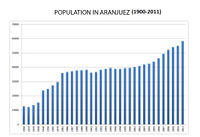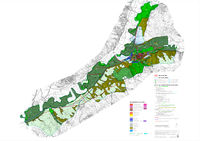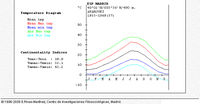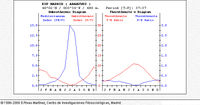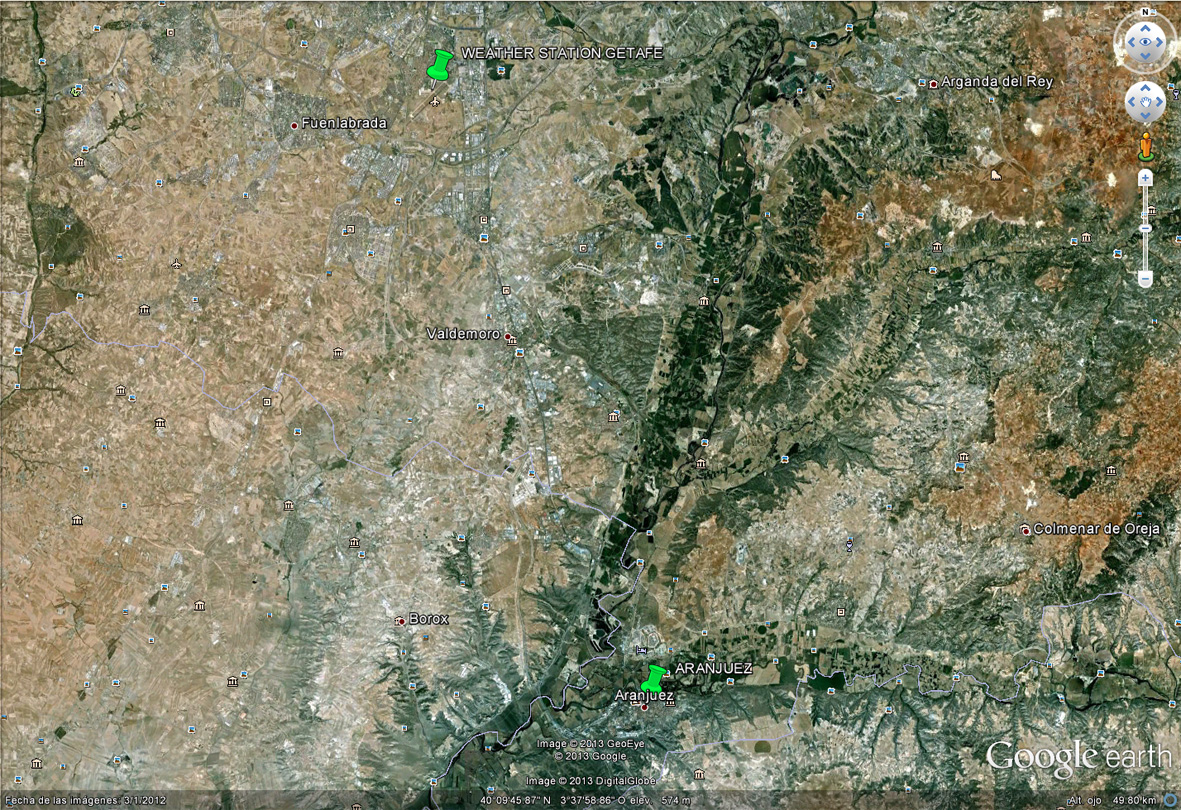Group D - Collaborative Climate Adaption Project
| Area | Aranjuez | |
| Country | Spain | |
| Topic | Effects of climate change and adaptation possibilities - case study from Aranjuez, Spain | |
| Author(s) | Eduardo Casado Fernández, Fang Yi, Daniela Staykova | |

| ||
|
| ||
Rationale: Why have you selected this case study area?
- Aranjuez is a town and lying 48 km south of Madrid in the southern part of the autonomous community of the Community of Madrid.
As of 2009, it has a population of 54,055. It is in the Wolrd Heritage List as Cultural Landscape. Climate change is affecting the gardens which are one of the most important elements of the cultural landscape and is affecting the massive trees, mainly specimens of Platanus x hispanica(more than 20-30 m high), and either urban planning is not being helpful either. There are also some other important problems, that should be addressed as soon as possible e.g. the nightmare of the access to the city and its collateral effects.
Authors' perspectives
- As landscape architecs we have an important role to play defining policies (i.e. urban ordinances) designing and applying strategies to improve urban design to preserve the core value of the Cultural Landscape of Aranjuez represented by the historical Gardens of Aranjuez linked to the Royal Palace. Also it is necessary to define policies for landscaping and integrating vegetation regarding other places of the city.
LANDSCAPE AND/OR URBAN CONTEST
Population In Aranjuez
Land Clasification in Aranjuez
History
Aranjuez it was the name of an ancient pasture that was understanding, approximately, the lands located among the Tajo and the Sea of Ontígola, of north to south, and the Street of the King and the Bare of the Star, of this to west. In the term of the ancient pasture, were found the village of Aranz, about the gasket of the Tajo rivers and Jarama. From the times of Felipe II, the name of Aranjuez served to designate to the Place, thereinafter Royal Place and, from the reign of Fernando VI, name of the population that here was seated.
The Aranjuez area enjoyed a long history of human settlement before becoming a strategic stronghold during Roman times. Then its position at a river crossing and cross roads - a factor to be repeatedly influential - gave it a significance in the political geography of the time. It lay in a sparsely populated region thereafter and was eventually granted by the Crown to the military order of St James of Santiago in the medieval period. Towards the end of the 14th century, the knights built a palace in the middle of the woods, then replete with game.
Aranjuez became a Royal site in the 15th century, but it was Philip II in the 16th century who created the first period of splendour. He built a new palace and large ornamental and vegetable gardens laid out according to geometric principles, attempting to symbolize his world-wide imperial sovereignty based on a centralized state while at the same time celebrating a return to nature, its structure, and man's supremacy according to the canons of Humanism. It was also a private and personal retreat. Phillip meanwhile pursued botanical experimentation, acclimatizing plant species from all over the world, and introduced hydraulic engineering based on best practice in central Europe and Italy. During the 17th century Aranjuez prospered as the annual abode of royalty, a place of pageantry and hunting, and a source of inspiration for and patronage of some of the greatest Spanish poets of the Golden Age.
The continuing splendour of the 18th century culminated in the building of a new town close to the palace. During the reign of Charles III, the city and its surrounding area became an experimental ground for physiocratic, agricultural, scientific, and social ideas lying at the heart of the Enlightenment. The King sought to provide exemplars both for horticultural practice and in the design of model farms. Such cultural grandeur effectively died when, under external pressure from French Revolutionary ideas and Napoleon's ambitions, the Aranjuez Riot at the end of the century signalled the end of Spain's Ancien Régime.
After a brief revival which added a new element of modernism and eclecticism to the Royal Site during the first half of the 19th century, the end of the reign of Isabella II marked the close of the Crown's exclusive role in the history of this riverside complex and community. A City Council was established independent of Royal command (1836) and the Royal family's use of Aranjuez decreased. At the Revolution in 1868, all Crown property passed to the State and, although large parts of Aranjuez were initially excepted, all that was left in Royal hands by the early 1870s were fragments of their former estate. Meanwhile, the population increased and a railway line (1851) stimulated vigorous economic activity at the price of cutting the Palace's eastern vistas and bisecting the Picotajo garden. During the 20th century Aranjuez became a densely populated satellite city of Madrid, an industrial and cultural centre in which memory and maintenance of the Royal Site deteriorated. Nevertheless, the Site overall kept its integrity, and by the end of that century new assessments, policies, and programmes of works reflected new attitudes of respect for the Royal Site. Source: UNESCO/CLT/WHC
- Biogeography, land use patterns, cultural features, overall character, history and dynamics
- ratio of green/blue and sealed/built-up areas
Illustration: Map; sketches; short descriptive analyses
Cultural/social/political context
Cultural Landscape Description
Justification for Inscription as Cultural Landscape (ICOMOS)
Criterion ii : Aranjuez represents the coming together of diverse cultural influences to create a cultural landscape that had a formative influence on further developments in this field.
Criterion iv : The complex designed cultural landscape of Aranjuez, derived from a variety of sources, mark a seminal stage in the development of landscape design.
The complex cultural landscape of Aranjuez, derived from a variety of sources, marks a seminal stage in the development of landscape design. It represents the coming together of diverse cultural influences to create a cultural landscape that had a formative influence on further developments in this field. Aranjuez has been witness to various cultural exchanges over a span of time, in a specific cultural area, that has had a tremendous influence in the development of its landmarks and the creation of its landscape.
Aranjuez represents a model for a given culture's use of its territory. However, the city has become increasingly vulnerable since the disappearance at the turn of the century of the Royal Court that had so much influence on its development. This area enjoyed a long history of human settlement before becoming a strategic stronghold during Roman times, with its position at a river crossing (the Tajo and the Jarama) and cross-roads, to the south of Madrid and to the north-west of Toledo. Towards the end of the 14th century, the knights built a palace in the middle of the woods, then replete with game. But it was Philip II in the 16th century who created the first period of splendour. He built a new palace and large ornamental and vegetable gardens laid out according to geometric principles and it was also a private and personal retreat. During the 17th century Aranjuez prospered as the annual abode of royalty, a place of pageantry and hunting, and a source of inspiration for the patronage of some of the greatest Spanish poets of the Golden Age.
The continuing splendour of the 18th century culminated in the building of a new town close to the palace. After a brief revival which added a new element of modernism and eclecticism to the royal site during the first half of the 19th century, the end of the reign of Isabella II marked the close of the Crown's exclusive role in the history of this riverside complex and community. At the Revolution in 1868, all Crown property passed to the State. By the early 1870s the population increased and a railway line (1851) stimulated vigorous economic activity at the price of cutting the palace's eastern vistas and bisecting the Picotajo garden. During the 20th century, Aranjuez became a densely populated satellite city of Madrid, an industrial and cultural centre. Nevertheless, the site overall kept its integrity. The whole area appears as a green oasis in a landscape otherwise of sierra type, dry, brown and fairly barren of vegetation as a result of climate, geomorphology, and over-exploitive land use.
The site incorporates a planned town, large gardens, vegetable gardens and orchards, lagoons, rivers and waterworks, woods, and moors. The main elements are the Palace and Island Garden, arranged around a plaza with, on the east, the King's Garden of irregular plan with fountains and, on the west, avenues and vistas eventually cut by the railway with, across a canal to the north, entirely within a sharp bend of the river beyond the Garden of the Statues and a fountain, the geometric Island Garden full of fountains and other structures; the Great Historic Garden consisting of a series of gardens which together comprise the bulk of the area; the urban area is subdivided into an industrial area west of the palace, incorporating the railway station and the gardens west of the palace, and the 18th-century town that is now the historic core of modern Aranjuez (the original town plan is intact); and the Prince's Garden, a late 18th- to early 19th-century garden that stretches along the south bank of the Tajo, north-east of the town. These elements are subsumed in a series of intermeshed landscapes, all combining conceptually to create a cultural landscape with rivers, dams, ditches, and fountains. The agricultural landscape is formed by vegetable gardens, orchards, nurseries and stock-breeding; the gardens form a delectable landscape. The geometry, starting with the grand alignments of Phillip II, also influenced parts of the hydraulic system, although clearly other factors were at play there; conversely, the hydrology fed the fountains and ponds, which were usually placed at particular points determined by geometry, albeit serving an aesthetic purpose.
The constructed landscape is formed by roads, architecture, and town. Both the natural and geometric bases of the site as a whole survive remarkably well, with relatively little loss and effectively (modern communication routes apart) no inappropriate intrusion. Major buildings as well as the city's layout and its gardens and tree-lined avenues have been preserved as the characteristic of an urban community among orchards and groves living on a ground plan. Source: UNESCO/CLT/WHC
- Brief explanation of culture, political economy, legal framework
Illustration: Bullet points, image, background notes
LOCAL CLIMATE
Climatic Data Period 1933-1969
Climatic Data Period 1971 -2000 (Getafe Weather Station)
Getafe - Aranjuez Location
Getafe Climatic Data
Aranjuez Average Climate Data up to 2009
Flood Ocurrence
- Which changes are expected? Is there any evidence?
Illustration: Table or time line
Analysis of vulnerability
- If you consider these potential changes - which aspects/functions of your case study would be affected?
Illustration: Map/diagram/sketches/photos/background notes
Proposals for Climate Change Adaption
- How could your case study area become more resilient to climate change?
- Which measures would need to be taken to adapt to the new situation?
- How could you assure sustainability of these measures?
- Please describe 2-3 measures
Proposals for Climate Change Mitigation
- Which measures would need to be taken to reduce greenhouse gas emissions and other drivers of climate change within your case study area?
- How could you assure sustainability of these measures?
- Please describe 2-3 measures
Your scenario
- How will this area look like in 2060?
- Please forecast one potential future development taking climate change into account
Illustration: Map/diagram/sketches photos and background notes
What can be generalized from this case study?
- Are there any important theoretical insights?
- Which research questions does it generate?
- Short statement plus background notes
Presentation Slides
- Addnewimagename.jpg
Slide One
- Addnewimagename.jpg
Slide Two
- Addnewimagename.jpg
Slide Three
Image Gallery
- Yourimage.jpg
your image text
- Yourimage.jpg
your image text
- Yourimage.jpg
your image text
- Yourimage.jpg
your image text
- Yourimage.jpg
your image text
- Yourimage.jpg
your image text
- Yourimage.jpg
your image text
- Yourimage.jpg
your image text
References
Please add literature, documentations and weblinks
About categories: You can add more categories with this tag: "", add your categories
